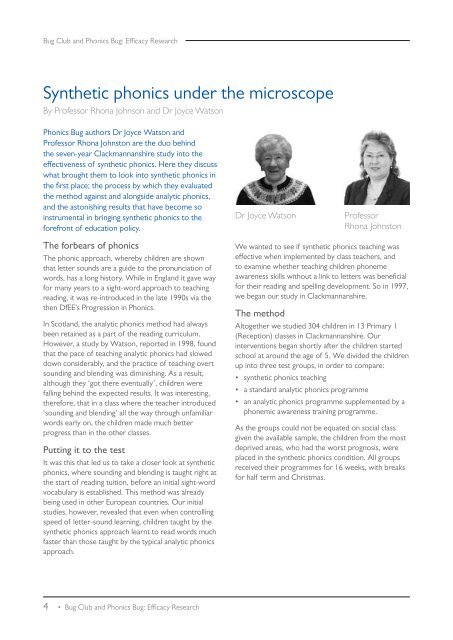Create successful ePaper yourself
Turn your PDF publications into a flip-book with our unique Google optimized e-Paper software.
Bug Club and Ph<strong>on</strong>ics Bug: Efficacy Research<br />
Synthetic ph<strong>on</strong>ics under the microscope<br />
By Professor Rh<strong>on</strong>a Johns<strong>on</strong> and Dr Joyce Wats<strong>on</strong><br />
Ph<strong>on</strong>ics Bug authors Dr Joyce Wats<strong>on</strong> and<br />
Professor Rh<strong>on</strong>a Johnst<strong>on</strong> are the duo behind<br />
the seven-year Clackmannanshire study into the<br />
effectiveness of synthetic ph<strong>on</strong>ics. Here they discuss<br />
what brought them to look into synthetic ph<strong>on</strong>ics in<br />
the first place; the process by which they evaluated<br />
the method against and al<strong>on</strong>gside analytic ph<strong>on</strong>ics,<br />
and the ast<strong>on</strong>ishing results that have become so<br />
instrumental in bringing synthetic ph<strong>on</strong>ics to the<br />
forefr<strong>on</strong>t of educati<strong>on</strong> policy.<br />
The forbears of ph<strong>on</strong>ics<br />
The ph<strong>on</strong>ic approach, whereby children are shown<br />
that letter sounds are a guide to the pr<strong>on</strong>unciati<strong>on</strong> of<br />
words, has a l<strong>on</strong>g history. While in England it gave way<br />
for many years to a sight-word approach to teaching<br />
reading, it was re-introduced in the late 1990s via the<br />
then DfEE’s Progressi<strong>on</strong> in Ph<strong>on</strong>ics.<br />
In Scotland, the analytic ph<strong>on</strong>ics method had always<br />
been retained as a part of the reading curriculum.<br />
However, a study by Wats<strong>on</strong>, reported in 1998, found<br />
that the pace of teaching analytic ph<strong>on</strong>ics had slowed<br />
down c<strong>on</strong>siderably, and the practice of teaching overt<br />
sounding and blending was diminishing. As a result,<br />
although they ‘got there eventually’, children were<br />
falling behind the expected results. It was interesting,<br />
therefore, that in a class where the teacher introduced<br />
‘sounding and blending’ all the way through unfamiliar<br />
words early <strong>on</strong>, the children made much better<br />
progress than in the other classes.<br />
Putting it to the test<br />
It was this that led us to take a closer look at synthetic<br />
ph<strong>on</strong>ics, where sounding and blending is taught right at<br />
the start of reading tuiti<strong>on</strong>, before an initial sight-word<br />
vocabulary is established. This method was already<br />
being used in other European countries. Our initial<br />
studies, however, revealed that even when c<strong>on</strong>trolling<br />
speed of letter-sound <strong>learning</strong>, children taught by the<br />
synthetic ph<strong>on</strong>ics approach learnt to read words much<br />
faster than those taught by the typical analytic ph<strong>on</strong>ics<br />
approach.<br />
4<br />
• Bug Club and Ph<strong>on</strong>ics Bug: Efficacy Research<br />
Dr Joyce Wats<strong>on</strong> Professor<br />
Rh<strong>on</strong>a Johnst<strong>on</strong><br />
We wanted to see if synthetic ph<strong>on</strong>ics teaching was<br />
effective when implemented by class teachers, and<br />
to examine whether teaching children ph<strong>on</strong>eme<br />
awareness skills without a link to letters was beneficial<br />
for their reading and spelling development. So in 1997,<br />
we began our study in Clackmannanshire.<br />
The method<br />
Altogether we studied 304 children in 13 Primary 1<br />
(Recepti<strong>on</strong>) classes in Clackmannanshire. Our<br />
interventi<strong>on</strong>s began shortly after the children started<br />
school at around the age of 5. We divided the children<br />
up into three test groups, in order to compare:<br />
• synthetic ph<strong>on</strong>ics teaching<br />
• a standard analytic ph<strong>on</strong>ics programme<br />
• an analytic ph<strong>on</strong>ics programme supplemented by a<br />
ph<strong>on</strong>emic awareness training programme.<br />
As the groups could not be equated <strong>on</strong> social class<br />
given the available sample, the children from the most<br />
deprived areas, who had the worst prognosis, were<br />
placed in the synthetic ph<strong>on</strong>ics c<strong>on</strong>diti<strong>on</strong>. All groups<br />
received their programmes for 16 weeks, with breaks<br />
for half term and Christmas.


